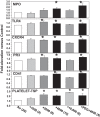Inflammatory responses to acute elevations of carbon dioxide in mice
- PMID: 28495847
- PMCID: PMC8091934
- DOI: 10.1152/japplphysiol.00343.2017
Inflammatory responses to acute elevations of carbon dioxide in mice
Abstract
Health risks are described from elevated indoor air carbon dioxide (CO2), which often ranges from 1,000 to 4,000 ppm, but the mechanisms are unknown. Here, we demonstrate that mice exposed for 2 h to 2,000 or 4,000 ppm CO2 exhibit, respectively, 3.4 ± 0.9-fold (SE, n = 6) and 4.1 ± 0.7-fold (n = 10) elevations in circulating microparticles (MPs); neutrophil and platelet activation, and vascular leak in brain, muscle, and distal colon. Interleukin (IL)-1β content of MPs also increases after 2,000 ppm by 3.8 ± 0.6-fold (n = 6) and after 4,000 ppm CO2 by 9.3 ± 1.1-fold (n = 10) greater than control. CO2-induced vascular damage is abrogated by treating mice with an antibody to IL-1β or an IL-1β receptor inhibitor. Injecting naïve mice with CO2-induced MPs expressing a protein found on mature neutrophils recapitulates vascular damage as seen with elevated CO2, and destruction of MPs in CO2-exposed mice abrogates vascular injuries without altering neutrophil or platelet activation. We conclude that environmentally relevant elevations of CO2 trigger neutrophils to generate MPs containing high concentrations of IL-1β that cause diffuse inflammatory vascular injury.NEW & NOTEWORTHY Elevated levels of CO2 are often found in indoor air and cause adverse health effects, but the mechanisms have not been identified. In a murine model, environmentally relevant levels of CO2 were found to cause diffuse vascular damage because neutrophils are stimulated to produce microparticles that contain high concentrations of interleukin-1β.
Keywords: indoor air quality; interleukin-1β; microparticles; neutrophil activation; vasculopathy.
Copyright © 2017 the American Physiological Society.
Conflict of interest statement
No conflicts of interest, financial or otherwise, are declared by the authors.
Figures



References
-
- Allen JG, MacNaughton P, Satish U, Santanam S, Vallarino J, Spengler JD. Associations of cognitive function scores with carbon dioxide, ventilation, and volatile organic compound exposures in office workers: A controlled exposure study of green and conventional office environments. Environ Health Perspect 124: 805–812, 2016. doi:10.1289/ehp.1510037. - DOI - PMC - PubMed
-
- Ayers L, Stoewhas AC, Ferry B, Stradling J, Kohler M. Elevated levels of endothelial cell-derived microparticles following short-term withdrawal of continuous positive airway pressure in patients with obstructive sleep apnea: data from a randomized controlled trial. Respiration 85: 478–485, 2013. doi:10.1159/000342877. - DOI - PubMed
MeSH terms
Substances
Grants and funding
LinkOut - more resources
Full Text Sources
Other Literature Sources

